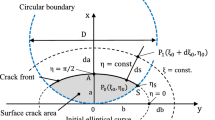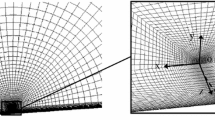Abstract
As a fatigue crack grows, its shape changes. The shape of the growing crack can be affected by the initial crack shape, the load type and the fatigue crack growth rate of the material. Existing methods to predict the shape of the growing crack include finite element simulation techniques, which typically require the computation of several hundred increments to get accurate results. This paper describes a new technique that uses growth circles to model the growing crack. Since the circles are perpendicular to the current crack front as well as to the new crack front, it represents the real path of the fatigue crack well and yields more accurate results. The new technique is to be applied to the case of a surface crack in a thick plate under tension or bending. The effects of the Paris-Erdogan exponent are also investigated.
Similar content being viewed by others
References
J. C. Newman and I. S. Raju, An empirical stress intensity factor equation for the surface crack, Engineering Fracture Mechanics, 15 (1981) 185–192.
Y. P Liu, C. Y. Chen, G. Q. Li and J. B. Li, Fatigue life prediction of semi-elliptical surface crack in 14MnNbq bridge steel, Engineering Fracture Mechanics, 17 (2010) 1413–1423.
M. D. Gilchrist and R. A. Smith, Finite element modelling of fatigue crack shapes, Fatigue & Fracture of Engineering Materials & Structures, 14 (1991) 617–626.
X. B. Lin and R. A. Smith, Shape growth simulation of surface cracks in tension fatigued round bars, International Journal of Fatigue, 19 (6) (1997) 461–469.
X. B. Lin and R. A. Smith, Finite element modelling of fatigue crack growth of surface cracked plates Part II: Crack shape change, Engineering Fracture Mechanics, 63 (1999) 523–540.
N. Couroneau and J. Royer, Simplified model for the fatigue growth analysis of surface cracks in round bars under mode I, International Journal of Fatigue, 20 (1998) 711–718.
Z. Wu, The shape of a surface crack in a plate based on a given stress intensity factor distribution, International Journal of Pressure Vessels and Piping, 83 (2006) 168–180.
R. Branco and F. V. Antunes, Finite element modelling and analysis of crack shape evolution in mode-I fatigue Middle Cracked Tension specimens, Engineering Fracture Mechanics, 75 (2008) 3020–3037.
R. Branco, F. V. Antunes, J. D. Costa and J. Barbosa, Numerical modelling of fatigure crack growth in shafts under tension and bending, 3 rd International Conference on Integrity, Reliability and Failure, Porto/Portugal (2009) S2011_P0363.
J. Toribio, J. C. Matos, B. González and J. Escuadra, Numerical modelling of crack shape evolution for surface flaws in round bars under tensile loading, Engineering Fracture Mechanics, 16 (2009) 618–630.
J. Toribio, J. C. Matos, B. González and J. Escuadra, Numerical modelling of cracking path in round bars subjected to cyclic tension and bending, International Journal of Fatigue, 58 (2014) 20–27.
P. Yu and W. Guo, An equivalent thickness conception for prediction of surface fatigue crack growth life and shape evolution, Engineering Fracture Mechanics, 93 (2012) 65–74.
J. H. Park and G. P. Nikishkov, Growth simulation for 3D surface and through-thickness cracks using SGBEM-FEM alternation method, Journal of Mechanical Science and Technology, 25 (9) (2011) 2335–2344.
I. S. Putra and J. Schijve, Crack opening stress measurements of surface cracks in 7075-T6 aluminium alloy plate specimen through electron fractography, Fatigue & Fracture of Engineering Materials & Structures, 15 (1992) 323–338.
Abaqus 6.9, 11.4.1 Fracture mechanics, Abaqus Analysis User’s Manual.
N. B. McFadyen, R. Bell and O. Vosikovsky, Fatigue crack growth of semi-elliptical surface cracks, International Journal of Fatigue, 12 (1990) 43–50.
S. X. Wu, Shape change of surface crack during fatigue growth, Engineering Fracture Mechanics, 22 (1985) 897–913.
Author information
Authors and Affiliations
Corresponding author
Additional information
Recommended by Associate Editor Youngseog Lee
Cong Hao Liu is currently a Ph.D. candidate in the School of Mechanical Engineering of the University of Ulsan, Korea; he began a combined M.S./Ph.D. program in 2009. His research interests include the fields of fracture and fatigue analysis, and finite element modeling and design, as well as vehicle-related fields.
Seok Jae Chu is a professor in the School of Mechanical Engineering of the University of Ulsan. He earned a bachelor’s degree from the Department of Mechanical Engineering of Seoul National University in 1979. He earned a master’s degree from KAIST in 1981 and a Ph.D. from KAIST in 1990.
Rights and permissions
About this article
Cite this article
Liu, C.H., Chu, S.J. Prediction of shape change of semi-elliptical surface crack by fatigue crack growth circles parameter. J Mech Sci Technol 28, 4921–4928 (2014). https://doi.org/10.1007/s12206-014-1111-5
Received:
Revised:
Accepted:
Published:
Issue Date:
DOI: https://doi.org/10.1007/s12206-014-1111-5




